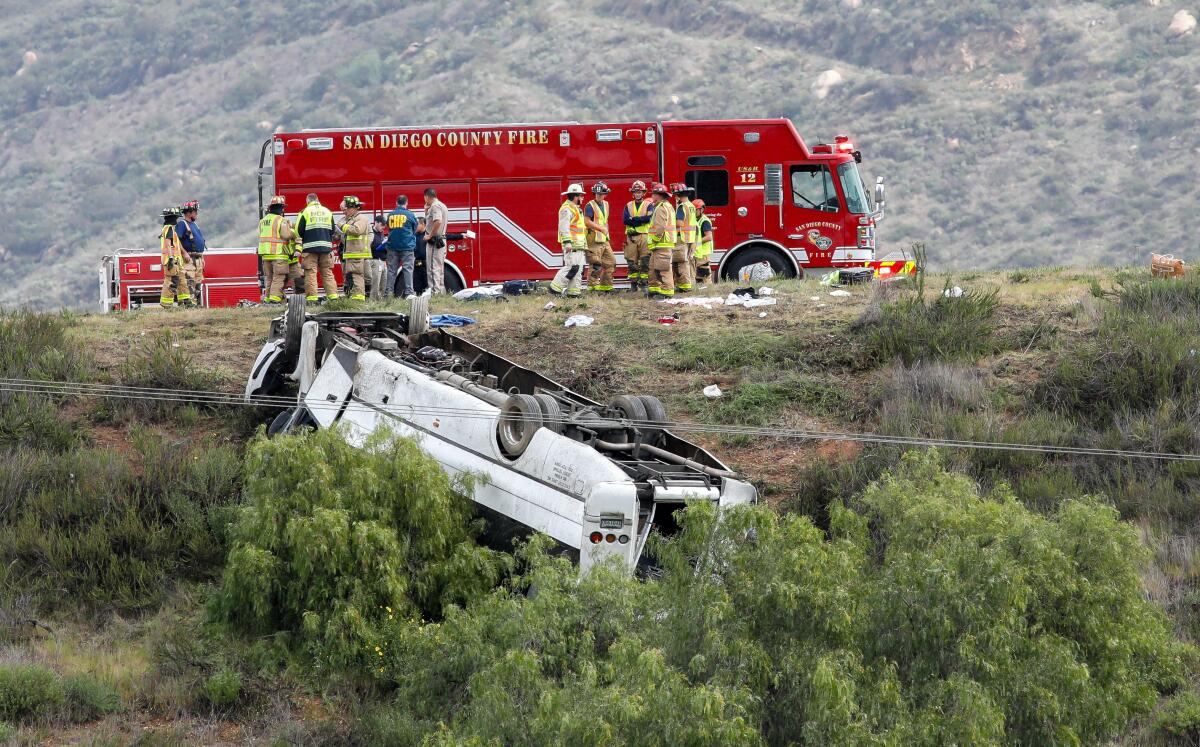Worn tires, driver mistakes led to deadly California bus rollover, NTSB says

- Share via
High speed, worn tire treads and other factors played a role in a deadly 2020 bus crash in San Diego County, according to a preview released this week of a report by the National Transportation Safety Board.
Three people died and 18 others were injured when the 30-passenger bus swerved off Interstate 15 amid rainy conditions on Feb. 22, 2020. The bus veered off the road, rolled upside down, then right side up, and landed on its back on an embankment, according to the federal agency’s findings announced Tuesday.
The bus was traveling from the Los Angeles area to San Ysidro and then to Tijuana, according to the California Highway Patrol. But by 10:20 a.m., the bus encountered rain. Several of the passengers were ejected from the vehicle, while others were trapped inside.
Federal investigators said that just one of the 20 passengers was wearing their seat belt at the time of the rollover crash near Pala Mesa.
Worn-down tire treads on two of the inside rear tires, which were lower than the minimum allowed level by federal law, contributed to the crash, the NTSB said. The outside tires also had marginal tread depths, which affected stability, the agency said.
The bus was traveling 73 mph to 75 mph just before the driver lost control, according to data from an engine module, too fast for the wet roadway and vehicle conditions, investigators said. Sustained braking and inconsistent steering contributed to the driver losing control, the federal agency said in its findings. NTSB expects to publish its full report in several weeks.
“This fatal crash serves as a stark reminder: Seat belts save lives and certain weather and road conditions require drivers to slow down,” NTSB Chair Jennifer Homendy said in a statement. “But bus operators also have an enormous safety responsibility to know — and follow — applicable laws, maintain their fleet and ensure safe speeds for conditions, as well as adequate driver training.”
NTSB said proper lap and shoulder belt use would have likely reduced injuries sustained during the crash. The passengers were not given any pre-trip safety briefing, according to interviews conducted by the NTSB. The agency recommends bus companies create policies on proper speed and safe driving in wet weather, while also asking the CHP to develop a public awareness program on proper seat belt usage.
The company’s carrier, Executive Lines Inc., said it was not aware of a California law requiring it to inform passengers about the state’s mandatory seat belt law. An email to the company was not immediately answered.
The report abstract does not say anything about the driver’s or bus company’s liability, and it’s unclear if the full report will determine that.
More to Read
Sign up for Essential California
The most important California stories and recommendations in your inbox every morning.
You may occasionally receive promotional content from the Los Angeles Times.











